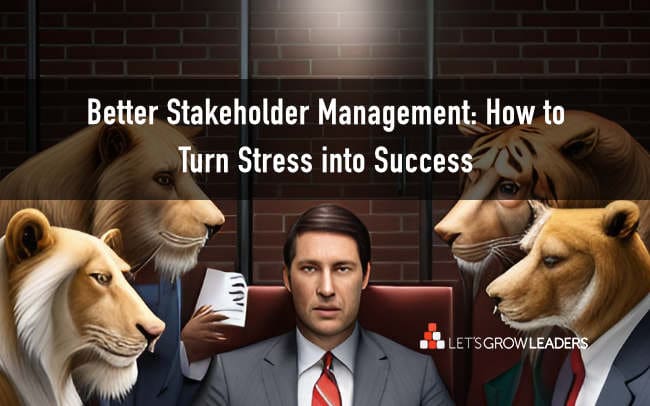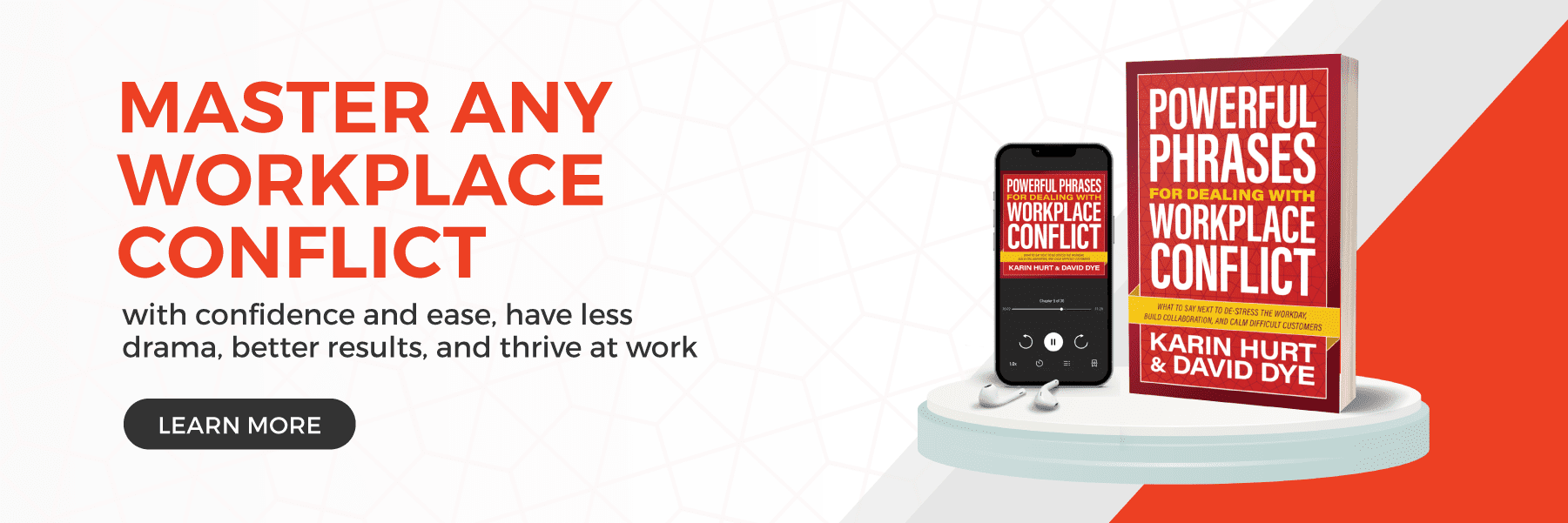 Use these communication techniques to keep even the most difficult stakeholders on your side
Use these communication techniques to keep even the most difficult stakeholders on your side
Stakeholder management is an art most of us learn the hard way. This article gives you some practical tips for better influence and less stress.
Sound familiar?
You glance at your phone, and your heart does a mini samba. It’s Last Minute Linda. The clock’s ticking down to your big presentation, and Linda decides now is the perfect time for her “Eureka” moment. Sure, you’re all for ideas and collective wisdom, but why couldn’t this epiphany have struck a week ago?
Just then you open your email there are five separate notes from Nervous Nora, asking you a whole series of “have you thought abouts…?” (which you have).
Then Can’t Commit Carl texts with another curveball asking you to postpone the meeting another week to give him some more time to think this through.
Oh, and here comes Over-Involved Ivan, who has taken the liberty of setting up a few extra focus groups (talking to the same people you did last week).
If you’ve been involved in stakeholder management for more than a minute, you’ve probably met a few of these well-meaning, challenging stakeholders.
Effective Strategies for Better Stakeholder Management
Here are a few approaches and what to say to destress your day, and keep your project on track.
1. Focus on Being Effective, Not Right
Set aside right, and focus on how you can be effective with your difficult stakeholders.
If Distracted Donna is feeling stressed and slowing you down by asking for information you’ve already shared, then the way you’ve been communicating isn’t working. You may have been “right” in that you updated her and she wasn’t listening, but you haven’t yet been effective.
You might say,
What if we set up a 15-minute check-in each week so I can give you exactly what you need? If we don’t have an important update, I’ll cancel it and send you a quick email.”
Nora may be anxious because she’s uncertain about outcomes. You might be “right” in telling her everything is under control, but you become “effective” when you present her with a contingency plan. This eases her anxieties and wins you a cooperative stakeholder.
You could approach Nora this way:
You’re raising some important concerns and I’ve thought about that too. Let me walk you through a few of our contingency plans. I want to ensure we’re addressing any of your big concerns.”
2. Pause to Breathe, Then Proceed
One particularly difficult aspect of stakeholder management is when your stakeholders get mean or cranky.
When you feel attacked, overlooked, slighted, ignored, devalued, or taken for granted it’s normal to be angry and ask “Why are they doing this to me?”
Take a moment to breathe and remind yourself that the other person’s actions aren’t about you. They’re trying to do the best they can with what they have. They didn’t wake up that morning thinking about how to make you angry.
If you need to take a few minutes to collect yourself, do it. You’re better off entering the conversation in a calm state of mind.
When emotions run high, clarity suffers. Take a moment to breathe, put emotions aside, and strategize calmly.
One stakeholder management superpower is knowing how to de-escalate a conversation. Here are a few powerful phrases that can help.
“I noticed that . . . What’s happening for you?”
One option is to observe what’s happening. When you calmly call attention to someone’s behavior and ask, “What’s happening for you?” it helps them take a breath and choose a different approach. For example, you might say, “I notice that you’re standing up and yelling. What’s going on for you right now?
“I appreciate you sharing that with me.”
This simple sentence works wonders in many stakeholder management scenarios. It works best when someone has shared a difficult perspective—something that they expect you won’t like. You’re not agreeing or disagreeing. Rather, you’re honoring their effort at communicating. It can also be a good way to take a pause in an ongoing conversation, so you have time to think about their perspective.
“How about a timeout?”
Sometimes you’ll need to call a timeout and give everyone time to calm down. Sometimes, when trust is very low, you might need to bring a third party or an advocate the other person trusts into the conversation to help moderate.
3. Engage with Empathy
Empathy is the most effective way to help you become more effective in your quest for stakeholder management. Try to see the world from their perspective. When you can understand why they act the way they do, you are in a better position to come up with constructive solutions.
Perhaps Distracted Donna is juggling three major strategic initiatives that consume her attention. Or, Can’t Commit Carl lives in the mental world of opportunity and “What could be” and doesn’t feel tied down by arbitrary due dates. He also cares – a lot.
Maybe Over-Involved Ivan has seen this movie before and it ended with him in a cameo role as “The Micromanager Who Knew Too Much.”
If you’re not sure what the world looks like from their perspective, you can always ask. eg: “What is most important about this assignment? I want to make sure we nail it – can you help me understand how this fits into the big picture?”
A few of our GOAT (Greatest of All Time) Powerful Phrases from our new book, Powerful Phrases for Dealing With Workplace Conflict, work well to express empathy and create a connection with your difficult stakeholder.
“I care about _____ (you, this team, this project) and I’m confident we can find a solution that we can all work with.”
Of course, this one requires sincerity. If your past behavior makes this statement questionable, you’ll want to supplement this one with a sincere apology as you state your intent for your future relationship.
“Tell me more.”
Nothing builds a connection like being seen, and this Powerful Phrase gets there in just three words. This prompt helps move through surface conversation and symptoms to deeper meaning. When you invite the other person to continue, they’ll often help you understand what they really want to say, what matters most to them, and you’ll avoid misunderstandings.
“It sounds like you’re feeling _____ is that right? [pause for affirmation]. Thank you for letting me know how you feel.”
Checking in with the other person to validate their feelings can help deescalate a conflict at any point in the conversation.
4. Seek Self-Awareness
One vital secret to effective stakeholder management is that they’re not the only “difficult” person in the mix. From their perspective, you might be the difficult one. We’re all someone else’s knucklehead.
In Over-Involved Ivan’s eyes, you might be the one not paying enough attention to detail. Counteract this by showing him that you do care about the minutiae, but also explain how zooming out to see the big picture can be equally crucial.
You might tell Ivan,
“I value your perspective. Could we schedule a quick meeting to discuss how things are going?”
Or,
“I appreciate your attention to detail, Ivan. I see why this particular point is a concern for you. However, if we focus too much on this, we risk losing sight of other essential aspects.”
5. Inform Intelligently
Different people need different information – differently. Remember, you want to be effective, not right. It does no good to send a monthly email when you know your key stakeholder receives information verbally and can give you a response quickly if you just walk down the hall or pick up your phone.
Do they need the full backstory or a quick summary of what happened and what you need? Do they want hourly updates or a weekly summary? Give people the information they need in the way they need it and your relationship will improve.
This is where many leaders get caught in the trap of being “right” but not effective. Just because you sent an email doesn’t mean you’ve communicated.
6. Plan Engagement
When you know that a key stakeholder is likely to engage too late, too often, or not at all, you can plan an intentional way to get their attention and input.
For someone like Linda. who you know will wait until the last minute to get involved, move the finish line. Specifically, seek her out and schedule a check-in before the final deadline.
You might ask Linda,
“Can we talk for five minutes – you’ve got something valuable to offer here.”
Tell her how much you value her perspective, and that you would love her input. If she doesn’t have thoughts now, give her a deadline that still allows you to get it done.
Yes, it takes a little extra effort compared to the place where everyone else is contributing, but the alternative is that dreaded phone call the night before. Savvy leaders know their stakeholders and get them involved when it makes the most sense.
For Nervous Nora and Over-involved Ivan: Sometimes, cutting through the ambiguity is the best approach. A candid conversation about expectations and worries can often set the stage for smoother interactions ahead.
“What would a successful outcome do for you?”
A Recipe for Success
Effective stakeholder management isn’t just about avoiding pitfalls; it’s about proactively transforming challenges into opportunities for growth and influence.








0 Comments